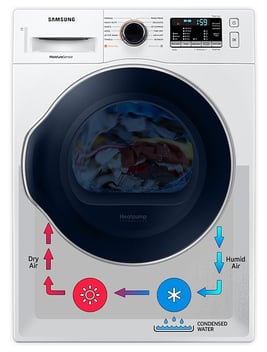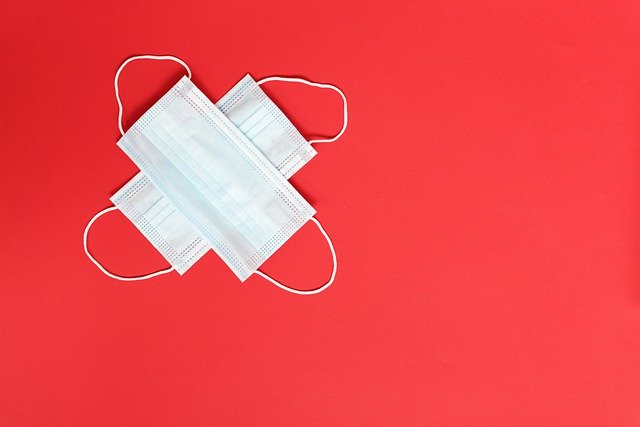I started this post before the COVID-19 pandemic. While a lot of our attention has shifted to slowing and fighting the pandemic, I hope you find some refreshment in a lighthearted but still important sustainability story.
One day a few months ago, Judy, my dog, started barking and running toward the door. I looked outside and saw a pair of burly bearded dudes opening the back of a large truck. The moment had finally arrived! This is one of those moments that makes me feel like an adult: buying an appliance. My new ventless heat pump dryer had arrived!
In an effort to reduce my personal fossil fuel use, I went with a type of dryer that’s uncommon in the US, so I wanted to share my experience so far.
Why Go Ventless?
Clearly, in order to meet emissions reductions goals, we need to move away from fossil fuels. Eventually, I’d like to completely stop burning natural gas in my house, but that will probably take a few years to achieve. My near-term goal is to convert all year-round appliances to electric. For me this includes my domestic hot water tank and my natural gas dryer. One reason I’m taking this approach is that if I don’t need any gas in the summer and fall, I can suspend my natural gas account, which saves me about $22 per month in access fees. These are the fees associated with things like reading the meter and administration/billing. Last time I checked with my utility, there is no fee for starting and stopping service as long as it’s off for at least 6 months. That’s $132 each summer in fees alone, which goes a long way toward helping pay for efficient appliances. Note that this doesn’t take into account the actual energy savings of the appliances.
Vented vs. Ventless
Conventional clothes dryers in the US are vented. They suck in air from your house, heat it up, push it through the clothes so it removes moisture, and then expel the air to the outside through a vent. Venting is especially important for gas dryers because the dyer needs to vent the combustion products, which can contain carbon monoxide.
Conventional electric dryers also need to be vented because the air leaving the dryer has lots of moisture and heat in it. Ventless electric dryers, on the other hand, remove moisture from the exhaust air which is then recirculated within the dryer. The condensed water vapor is piped to drain or goes into a vessel that can be dumped into a sink.
One thing that bugs me about my existing gas dryer is that it is heating air up only to dump it outside. My dryer is rated at 22,000 BTU/hr. That is enough to heat my house most days (of course, I’m not running my dryer all winter), and yet the dryer is dumping all that heat outside. Not only that, but the dryer is sucking air from the basement. That air must be replaced. Like most homes, I don’t have a mechanical ventilation source. So the air going out the dryer is made up by cold outside air (in the Winter) being sucked in through little cracks and gaps throughout the house, and that cold air has to be heated up by my furnace.
Heat Pump Dryers

If you’re not familiar, a heat pump is basically like an air conditioner. It has a cold side (evaporator), and a warm side (condenser), and it moves heat from one location to another. Whereas your air conditioner has an indoor part and an outdoor part, the dryer has all those components in a small section within the dryer. Air is cycled in a loop throughout the dryer. As moist air leaves the main compartment, it goes through the evaporator side of the heat pump, which cools the air door. By cooling the air down, moisture condenses into water and the air dryers out. Then the air passes through the condenser section (equivalent to the outdoor part of your air conditioner), which heats it up. Then that warm dry air goes through the main compartment and removes moisture from your clothes, and the cycle continues!
As far as I can tell, my dryer doesn’t really bring in or exhaust air. It has an ‘air intake’ but it doesn’t seem to bring in a noticeable amount of air, so I think its just there to make up air that is lost through leaks. So basically, it is a box where the inputs are electricity and wet clothes, and the outputs are water, dry clothes, and some heat.
Helping Heat My Home
Above, I described how my gas dryer sucks cold air into my house. Conversely, my ventless heat pump dryer doesn’t impact the pressure within the house and thus doesn’t suck cold air through leaks. In addition, the electricity used by the dryer ultimately ends up turning into heat, which helps heat my house! Now, it is only rated at 800 Watts (equivalent to 2,700 BTU/hr), and likely doesn’t use that consistently, but still, that’s essentially free heat. In cold places like Vermont, that is great. It’s not as great in cooling-dominated climates or if your dryer is located in a small space that could overheat. But for me, it’s helping me keep my basement a bit warmer than it would normally be. Also, when it is hot in the middle of the summer and I don’t want the heat, I’ll likely be drying cloths outside.
Features
Lint Filter: My old dryer had a typical wire mesh filter to catch lint. The new dryer has a lint filter that is some synthetic materially with smaller weave. It also has an inner and outer filter layer, so air passes through two layers. I believe that this is done to prevent the fins in the heat exchanger from getting dirty. The filter takes a bit longer to clean then a traditional dryer’s filter, but it probably only adds a few seconds.
Moisture Sensor: These seem to be pretty standard at this point, but it’s a nice efficiency feature. Rather than guessing how long a load will take, a moisture sensor keeps the load running until its dry enough. In my old dryer, we’d probably run it an extra 5-10 minutes each load because we didn’t want to have to come check on it multiple times.
Drawbacks
Run Time: The main downside of this appliance is that it takes longer to run. A normal load takes almost two hours. Probably about twice as long as a normal dryer. It does have an express setting that will dry a small load in 40 minutes. Overall, for me, the cycle time doesn’t bother me because I’m never really sitting waiting for a load to complete.
Dryer Effectiveness: Generally, the dryer has worked fine; however, the times we’ve used the sensor dry option for a load of sheets, the sheets get tangled and the center doesn’t fully dry, which is annoying. I think this is an instance when the ‘sensor dry’ option doesn’t work well. The tangled sheets are damp in the center, but dry on the outside, so the sensor thinks the load is done and stops the dryer. Using the timed drying options seems to work better. I would also recommend getting a larger unit than ours (4.2 cubic feet) if you plan to dry large loads of sheets and don’t want any hassle.
Resources
Both Burlington Electric Department and Efficiency Vermont offer generous incentives for efficient dryers. My rebate covered about 40% of the appliance’s cost.


